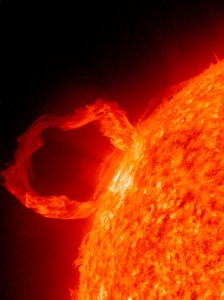Solar Storm (Coronal Mass Ejection) – Thursday March 08, 2012
The most powerful solar storm in half a decade is about to hit our planet Earth, putting electrical systems, satellite navigation and other technology at a slight risk of failure.
The Sun released a Coronal Mass Ejection, a mighty explosion of plasma, on Tuesday evening. The effects of that ejection should strike Earth at approximately 7 a.m. ET on Thursday morning and last until Friday, according to the federal government’s Space Weather Prediction Center.
Source : Mashable.comEnergy Conservation Focus: Self Explanitory.
This is one of those entries which will most likely not have much of a response at the time of it’s posting, yet may serve as a clear explanation for mysterious and hard to explain events in the future.
Basically, it has to do with energy, and in this particular case enormous amounts of Solar energy and while the scientists are claiming that it’s (Solar Mass Ejection) effects should not have a noticeable effect on daily life on Earth, the planet’s magnetic fields are without a shadow of a doubt, affected and whether or not there is a connection as to why this particular week was declared as Energy Conservation Week before learning of this Solar Storm remains to be seen.
Earth’s Magnetic Field
Earth’s magnetic field (also known as the geomagnetic field) is the magnetic field that extends from the Earth’s inner core to where it meets the solar wind, a stream of energetic particles emanating from the Sun. It is approximately the field of a magnetic dipole tilted at an angle of 11 degrees with respect to the rotational axis—as if there were a bar magnet placed at that angle at the center of the Earth. However, unlike the field of a bar magnet, Earth’s field changes over time because it is really generated by the motion of molten iron alloys in the Earth’s outer core (the geodynamo). The Magnetic North Pole wanders, fortunately slowly enough that the compass is useful for navigation. At random intervals (averaging several hundred thousand years) the Earth’s field reverses (the north and south geomagnetic poles change places with each other). These reversals leave a record in rocks that allow paleomagnetists to calculate past motions of continents and ocean floors as a result of plate tectonics. The region above the ionosphere, and extending several tens of thousands of kilometers into space, is called the magnetosphere. This region protects the Earth from cosmic rays that would strip away the upper atmosphere, including the ozone layer that protects the earth from harmful ultraviolet radiation.
Source: wikipedia.org




